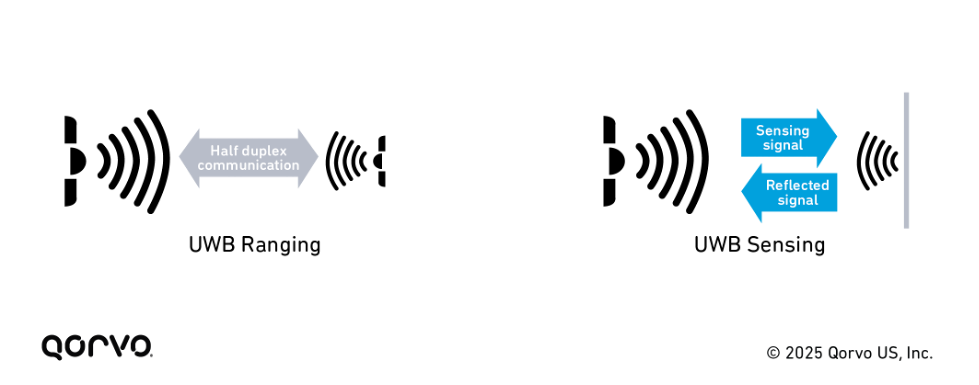Ultra-Wideband (UWB) Radar: Beyond Ranging to Advanced Sensing
March 17, 2025
What is Ultra-Wideband (UWB) Radar?
UWB is widely regarded as the best ranging technology for precise, secure, real-time measurement of location, distance and direction. What UWB also offers is the ability to operate as an ambient sensing technology through radar. Like ranging, UWB radar leverages UWB's extremely wide 500MHz bandwidth and short 2 nanosecond pulses to provide highly precise detection of objects and people. Unlike ranging, however, UWB radar does not require two devices to communicate, instead capturing signal reflections with a single device (Figure 1). As a result, it is a low cost and low power solution, and when combined with omni-directional antennas, it can detect movement within a 360° field of view, enabling full area monitoring with minimal coverage gaps. Additionally, UWB ranging and radar can be combined to enable multifunctional capabilities, such as sensing presence and then securely authenticating.

How UWB Radar Senses with Precision
The magic of UWB sensing works by transmitting radar pulses while simultaneously receiving multipath signal reflections from objects and people. These estimated channel impulse responses (CIR) are then processed by advanced radar algorithms to not only detect movement but also estimate the distance and location (Figure 2). UWB radar has a high level of immunity to interference, enabling reliable performance even in dense multipath, multi-radio environments where other sensing technologies can struggle.

The novelty of UWB radar is that key radar parameters can be configured to tradeoff range, power consumption and coverage area. The more samples that are collected per radar sweep, the longer the detection range—from a few centimeters to several meters. In addition, if the transmitted radar frame is repeated at a higher rate, it will result in a more accurate location estimate at the expense of higher power consumption.
Even with a use case to detect presence up to several meters, UWB radar consumes less than 10mW, making it an optimal low power technology for portable devices, extending battery life and reducing the need for frequent charging. Moreover, UWB radar's ability to monitor vital signs or recognize gestures opens the door to new ways for users to interact with smart devices. By detecting minute movements and specific gestures, it facilitates intuitive and touch-free control interfaces. This is especially advantageous in healthcare and automotive applications, where non-contact interactions enhance safety, security and convenience. Overall, the versatility of UWB radar coupled with its fine-ranging (< 10 cm) accuracy make it a compelling solution that can deliver precise, reliable and energy-efficient performance across a wide range of applications.
Contrast with Other Sensing Technologies
When evaluating UWB radar alongside other technologies like Passive Infrared (PIR) sensors, several critical differences highlight the strengths of UWB. PIR sensors are commonly used for motion detection, but they only work when the sensor has clear line-of-sight (LOS). They have a limited field of view and are sensitive to environmental factors such as temperature changes, dust and bright light. In contrast, UWB radar operates effectively in LOS and non-line-of-sight (NLOS) conditions, can penetrate walls and maintain accuracy and resolution despite challenging environmental conditions. These attributes make UWB a more versatile solution for many applications.
Compared to 60 GHz millimeter-wave (mmWave) radar, UWB radar offers a different set of advantages. While mmWave radar is effective in specific use cases, such as detecting presence with security cameras or smart thermostats, it typically consumes more power, is more complex to implement and comes with higher solution costs. UWB radar, on the other hand, consumes less power, is simpler to implement and is cost-effective, making it a viable alternative to 60 GHz mmWave radar, especially for short-range radar applications.

An important point to remember is that depending on the application, each sensing technology has its own unique advantages. PIR sensors, for example, are excellent for basic motion detection in simple environments, while mmWave radar is valuable where high-precision sensing or high-resolution imaging is needed. UWB radar shines where versatility, precision and multi-functionality are required, such as the combination of sensing and fine ranging.
Sensing UWB Radar's Ability to Transform Different Markets
UWB radar technology redefines sensing applications across consumer, enterprise and automotive markets. By combining UWB's high-precision radar capabilities with fine ranging, this technology enables not only presence detection but also highly accurate distance measurement, unlocking a range of innovative and seamless user experiences. Figure 3 illustrates the core sensing functionalities of UWB radar, which can be deployed individually or in combination with fine ranging to enhance security, automation and interactivity. The following sections will explore how UWB radar is driving transformation in these markets, delivering advanced functionality and elevating user experiences in ways that traditional sensing technologies cannot.

Smart Spaces and Ecosystems
By enabling highly accurate presence detection and motion monitoring, UWB radar redefines the way we interact with smart spaces. Unlike conventional security systems that rely on always-on cameras, UWB radar offers an alternative that prioritizes privacy while maintaining security and functionality. Instead of continuous surveillance, UWB radar can detect human presence and movement, activating in-home cameras only when necessary or eliminating the need for them altogether. This approach mitigates cybersecurity risks, such as unauthorized access to security cameras, while ensuring comprehensive monitoring.
Beyond security, UWB radar enhances the adaptability of smart home environments. It can differentiate between humans and inanimate objects to reduce false alarms and enable more responsive automation. Lights, climate controls and other smart systems can adjust dynamically based on occupancy to improve convenience and energy efficiency. Additionally, UWB radar's gesture recognition can enable touch-free control of appliances such as kitchen faucets, trash cans or even entertainment systems to further enhance convenience and hygiene in the home.
In enterprise settings, UWB radar embedded in ceiling-mounted Wi-Fi enterprise access points (EAPs) or video bar cameras can enable precise occupancy sensing. When combined with AI and imaging systems, it helps businesses optimize workspace utilization by tracking the number of people in a room. This data-driven approach allows organizations to enhance energy efficiency by adjusting HVAC and lighting systems, managing meeting room reservations more effectively, and improving overall operational productivity. By integrating UWB radar, enterprises can create smarter, more efficient workplaces without compromising security or privacy.
Health & Wellness
UWB radar's ability to monitor vital signs without physical contact has the potential to revolutionize patient care in both clinical and home settings. Its high precision allows it to detect subtle movements associated with breathing and heart rate, making it an ideal solution for neonatal monitoring, elder care and remote patient observation. This non-invasive approach improves comfort for patients while ensuring continuous and reliable health tracking.
Additionally, UWB radar can function effectively even when a patient is covered by blankets, bedding or clothing, providing uninterrupted monitoring without requiring direct skin contact. This is particularly valuable in intensive care units, where minimal patient disturbance is crucial, or in-home healthcare scenarios where discreet, passive monitoring enhances quality of life. Furthermore, its ability to sense through physical obstructions makes it a powerful technology for monitoring patients in isolation rooms or settings where traditional monitoring devices may be impractical.
Seamless Access & Control
UWB radar also shines in access control, offering robust, secure identification and authentication solutions. In office, warehouse or enterprise environments, UWB radar enhances access control systems by detecting an individual's presence and movement, then securely authenticating their identity when combined with UWB fine-ranging. The same UWB chip can interact with a UWB-enabled badge, smartwatch or smartphone to confirm identity and grant secure access. This capability is especially critical in industries like finance, research and data centers, where stringent security measures are essential.
Beyond traditional access control, UWB radar's gesture recognition capabilities introduce a new dimension of interaction in enterprise environments. Imagine employees controlling meeting room displays with a simple wave of their hand, reducing the need for physical contact with shared surfaces. Looking ahead, computers equipped with UWB radar could recognize subtle gestures indicative of stress or fatigue to enable workplaces to develop smarter, more responsive wellness solutions without intrusive monitoring.
Automotive Safety & Infotainment
UWB radar is driving advancements in vehicle safety and convenience by enabling highly precise, real-time detection capabilities. One of its most critical applications is Child Presence Detection (CPD), mandated by Euro NCAP, which helps prevent tragic incidents by detecting the presence of infants left behind in vehicles. By monitoring subtle breathing and heart rate movements, UWB radar can be used to send instant alerts to caregivers or authorities when a life is at risk. As vehicles become more intelligent and connected, UWB radar also paves the way for next-generation intelligent interiors. Future implementations may include gesture-based controls to allow drivers to adjust infotainment systems, climate settings or navigation interfaces with simple hand movements. This not only enhances convenience but also minimizes distractions, further contributing to a safer driving experience.
Future Prospects and Innovations
UWB radar's versatility, reliability and precision redefine the possibilities for sensing technologies—paving the way for smarter, safer and more intuitive environments. Its wide bandwidth and short pulse characteristics deliver a uniquely differentiated sensing capability, making it an optimal choice for applications that require precise and accurate localization.
The future is brimming with potential for UWB radar, offering low power consumption, high performance and an uncanny ability to combine sensing and ranging in a single solution. As advancements in algorithms and integrations with AI on the edge and machine learning continue, UWB radar will evolve into an even more powerful tool for precise and adaptive sensing. Whether it's enhancing automotive safety, enabling touch-free healthcare solutions or driving efficiency in enterprise environments, UWB radar's potential for seamless interactions is undeniable.
About the Author
Sri Sridharan
Sri leads the expansion of Qorvo's IoT connectivity solutions in North America, focusing on Ultra-Wideband (UWB) and Bluetooth LE/Matter technologies. As an award-winning product definer and published author, he brings deep expertise in RF components and systems, including Cellular, Bluetooth LE, GPS, LoRa and RFID. By working closely with customers to understand their specific use cases and challenges, Sri strategically influences Qorvo’s product roadmap, ensuring alignment with market needs and technological trends.
Have another topic that you would like Qorvo experts to cover? Email your suggestions to the Qorvo Blog team and it could be featured in an upcoming post. Please include your contact information in the body of the email.